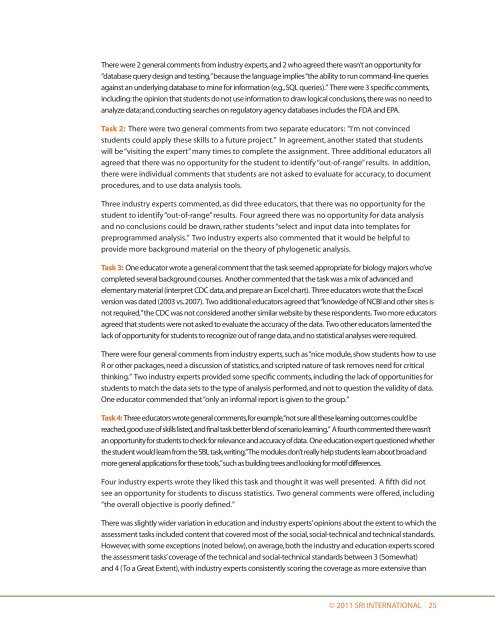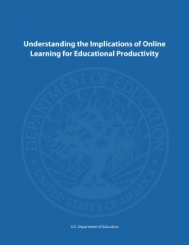Download PDF - SRI International
Download PDF - SRI International
Download PDF - SRI International
Create successful ePaper yourself
Turn your PDF publications into a flip-book with our unique Google optimized e-Paper software.
There were 2 general comments from industry experts, and 2 who agreed there wasn’t an opportunity for<br />
“database query design and testing,” because the language implies “the ability to run command-line queries<br />
against an underlying database to mine for information (e.g., SQL queries).” There were 3 specific comments,<br />
including: the opinion that students do not use information to draw logical conclusions, there was no need to<br />
analyze data; and, conducting searches on regulatory agency databases includes the FDA and EPA.<br />
Task 2: There were two general comments from two separate educators: “I’m not convinced<br />
students could apply these skills to a future project.” In agreement, another stated that students<br />
will be “visiting the expert” many times to complete the assignment. Three additional educators all<br />
agreed that there was no opportunity for the student to identify “out-of-range” results. In addition,<br />
there were individual comments that students are not asked to evaluate for accuracy, to document<br />
procedures, and to use data analysis tools.<br />
Three industry experts commented, as did three educators, that there was no opportunity for the<br />
student to identify “out-of-range” results. Four agreed there was no opportunity for data analysis<br />
and no conclusions could be drawn, rather students “select and input data into templates for<br />
preprogrammed analysis.” Two industry experts also commented that it would be helpful to<br />
provide more background material on the theory of phylogenetic analysis.<br />
Task 3: One educator wrote a general comment that the task seemed appropriate for biology majors who’ve<br />
completed several background courses. Another commented that the task was a mix of advanced and<br />
elementary material (interpret CDC data, and prepare an Excel chart). Three educators wrote that the Excel<br />
version was dated (2003 vs. 2007). Two additional educators agreed that “knowledge of NCBI and other sites is<br />
not required,” the CDC was not considered another similar website by these respondents. Two more educators<br />
agreed that students were not asked to evaluate the accuracy of the data. Two other educators lamented the<br />
lack of opportunity for students to recognize out of range data, and no statistical analyses were required.<br />
There were four general comments from industry experts, such as “nice module, show students how to use<br />
R or other packages, need a discussion of statistics, and scripted nature of task removes need for critical<br />
thinking.” Two industry experts provided some specific comments, including the lack of opportunities for<br />
students to match the data sets to the type of analysis performed, and not to question the validity of data.<br />
One educator commended that “only an informal report is given to the group.”<br />
Task 4: Three educators wrote general comments, for example, “not sure all these learning outcomes could be<br />
reached, good use of skills listed, and final task better blend of scenario learning.” A fourth commented there wasn’t<br />
an opportunity for students to check for relevance and accuracy of data. One education expert questioned whether<br />
the student would learn from the SBL task, writing, “The modules don’t really help students learn about broad and<br />
more general applications for these tools,” such as building trees and looking for motif differences.<br />
Four industry experts wrote they liked this task and thought it was well presented. A fifth did not<br />
see an opportunity for students to discuss statistics. Two general comments were offered, including<br />
“the overall objective is poorly defined.”<br />
There was slightly wider variation in education and industry experts’ opinions about the extent to which the<br />
assessment tasks included content that covered most of the social, social-technical and technical standards.<br />
However, with some exceptions (noted below), on average, both the industry and education experts scored<br />
the assessment tasks’ coverage of the technical and social-technical standards between 3 (Somewhat)<br />
and 4 (To a Great Extent), with industry experts consistently scoring the coverage as more extensive than<br />
© 2011 <strong>SRI</strong> INTERNATIONAL 25
















